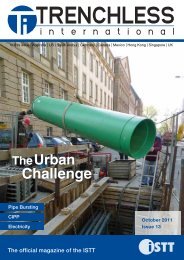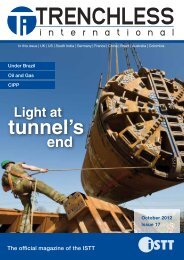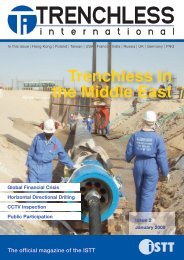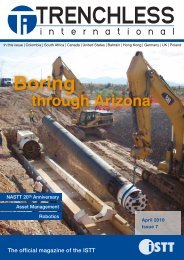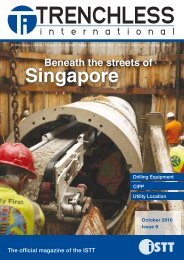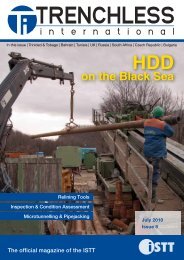North American Special - Trenchless International
North American Special - Trenchless International
North American Special - Trenchless International
Create successful ePaper yourself
Turn your PDF publications into a flip-book with our unique Google optimized e-Paper software.
Risky business<br />
by Roderick Lovely<br />
asset management<br />
April 2009 - <strong>Trenchless</strong> <strong>International</strong><br />
1%<br />
20%<br />
36%<br />
3%<br />
Total miles of pipe by material<br />
9%<br />
52%<br />
3%<br />
Managing assets<br />
in Las Vegas<br />
<strong>Trenchless</strong> Technology contributes substantially to asset management across the world. Charles Scott<br />
from the Las Vegas Valley Water Department spoke with <strong>Trenchless</strong> <strong>International</strong> about their asset<br />
management program.<br />
Las Vegas is the most populous<br />
city in the USA state of Nevada. The<br />
Las Vegas Valley, a 600 square mile<br />
(1600 km²) basin and surrounding area, is<br />
part of Clark County in southern Nevada.<br />
Mr Scott says the Las Vegas Valley<br />
Water District (LVVWD) is responsible for<br />
over 4,500 miles of pipe in Las Vegas and<br />
unincorporated Clark County. Mr Scott<br />
says “We also manage over 100 miles of<br />
pipe in separate small water systems in<br />
the communities of Jean, Searchlight, Blue<br />
Diamond, Laughlin, and Kyle canyon.”<br />
The breakdown of total miles of pipe by<br />
material is shown below.<br />
The largest steel pipe, including mortar<br />
lined steel pipe, bar wrapped steel pipe<br />
and pre-tensioned wire wrapped pipe is<br />
102 inches in diameter. Most pipe in this<br />
class ranges from 24-48 inches in diameter.<br />
PVC pipe ranges from 4 inches up<br />
to 42 inches and ACP from 4 inches to<br />
60 inches. Most PVC and ACP pipe are<br />
from 6 – 8 inches.<br />
Mr Scott says that because of Las Vegas’<br />
phenomenal population growth over the<br />
past ten years, the average age of all pipes<br />
in the distribution system is only about 18<br />
years. The average age for PVC pipe is<br />
eight years compared to ACP, which has<br />
an average age of between 29 and 34<br />
years.<br />
ACP has the highest break rate per mile<br />
compared with all other pipe materials.<br />
When asked what portion of assets the<br />
LVVWD inspects every year, Mr Scott says<br />
they are currently focusing assessment<br />
activities on ACP and steel pipe. “For ACP,<br />
our assessments are prioritised based on<br />
our CARE-W [computer aided rehabilitation<br />
of water networks] model that ranks pipe in<br />
terms of risk of failure – based on statistical<br />
failure modelling and hydraulic criticality –<br />
based on hydraulic modelling tool re-net.<br />
Asbestos cement<br />
Cast Iron<br />
Unknown<br />
Ductile iron<br />
PVC<br />
Polyethylene<br />
Mortar lined steel<br />
“We also try to employ the<br />
best available technology<br />
and use non-invasive<br />
techniques as much as<br />
possible.”<br />
“Other criteria such as impact to customers,<br />
potential damage to rods and<br />
types of customer served are also important<br />
considerations,” says Mr Scott.<br />
For steel, the LVVWD assessments are<br />
prioritised based on corrosion potential<br />
information collected from the Cathodic<br />
Protection system, as well as the potential<br />
consequences of failure, impact to customers<br />
and break history.<br />
“We have just this year implemented<br />
our CARE-W model, and have started a<br />
full-blown assessment program,” says Mr<br />
Scott. “This year we will assess approximately<br />
10 miles of ACP, and from 10 up to<br />
15 miles of steel pipe.”<br />
Mr Scott says that the total amount of<br />
ACP to be assessed each year will vary<br />
depending on the output of the model. The<br />
LVVWD plans on assessing approximately<br />
20 miles of steel pipe annually.<br />
<strong>Trenchless</strong> <strong>International</strong> asked if the<br />
District has adequate funding to conduct<br />
the inspection and repair programs. Mr<br />
Scott answered “Funding is a challenge<br />
for all utilities, this is why we are careful to<br />
assess only those pipes at the most risk.”<br />
The LVVWD is just beginning to investigate<br />
the advantages of <strong>Trenchless</strong><br />
Technology following a successful CIPP<br />
project. The District will be evaluating the<br />
applicability of <strong>Trenchless</strong> solutions on a<br />
case by case basis.<br />
Quantifying risk is fundamental to any physical asset management program, the following article<br />
presents how this information can be obtained and used to assess risk.<br />
Water and wastewater infrastructure<br />
managers make decisions every day<br />
that are aimed at reducing the risk of costly<br />
failures. For most, the decision process is<br />
ingrained, based on years of experience<br />
and knowledge in system management.<br />
But over time systems change, people<br />
retire, the knowledge base is lost, assets<br />
age, and the probability of costly failures<br />
increases. This is especially true in<br />
developed countries where underground<br />
utilities have been in place for over a hundred<br />
years, and the people who manage<br />
them are nearing retirement.<br />
As a new generation of managers<br />
emerges, they are being asked to manage<br />
assets that are nearing the end of<br />
their useful life with fewer resources, and<br />
tougher regulatory requirements, such as<br />
California’s Sanitary Sewer Management<br />
Plan, or SSMP. To cope with these challenges,<br />
savvy managers are turning to<br />
computer applications with physical asset<br />
management (PAM) features to allocate<br />
limited resources more strategically.<br />
Fundamental to PAM is prioritisation of<br />
assets based on a risk model. At a minimum,<br />
this involves knowing how assets<br />
might fail and what would happen if a<br />
failure were to occur. In PAM we define<br />
‘how assets might fail’ as the probability<br />
of failure (PoF) and ‘what would happen a<br />
failure were to occur’ as the consequence<br />
of failure (CoF). Risk is simply the product<br />
the PoF and CoF:<br />
Risk = PoF x CoF.<br />
Probability of failure<br />
To determine the PoF of any asset we<br />
must first determine how it may fail in terms<br />
of failure modes. When we categorise how<br />
an asset may fail there are at least four<br />
failure modes to consider that are common<br />
to all assets.<br />
Condition<br />
Condition may be put in terms of a<br />
Condition Rating by quantifying the number<br />
and extents of defects, or by direct measures<br />
such as a vibration analysis. It may be<br />
helpful to measure condition in both O&M<br />
Condition and Physical Condition. O&M<br />
Condition can be addressed through tasks<br />
such as cleaning and lubrication, while<br />
Physical Condition may call for capital remedies<br />
such as overhaul and replacement.<br />
Probability<br />
What it means<br />
100 per cent Failure likely to occur within a year<br />
90<br />
90 per cent chance of Failure in any year – Failure likely within 2<br />
years<br />
50 50 per cent chance of Failure within any year<br />
20 20 per cent chance of Failure within any year<br />
10<br />
2<br />
10 per cent chance of Failure within any year – 90 per cent<br />
chance it won’t<br />
2 per cent chance of Failure within any year - 98 per cent<br />
chance it won’t<br />
Age<br />
For age to have meaning we must<br />
first determine the life expectancy of any<br />
asset. Life expectancy can be influenced<br />
by many factors such as the surrounding<br />
environment, construction material, and<br />
installation techniques. Although age is<br />
often a good predictor of condition, an<br />
asset that appears to be in good condition<br />
may start to deteriorate rapidly or suddenly<br />
fail as it approaches the end of its<br />
useful life. Knowing how close your assets<br />
are to the end of their life expectancy may<br />
influence how often you inspect them or<br />
how you develop a replacement strategy<br />
to avoid costly failures.<br />
Capacity<br />
Does the demand placed on the asset<br />
exceed its original design capacity<br />
Influences such as population increases<br />
can certainly affect capacity. You must<br />
know what the demands are on your<br />
assets to measure capacity. Bear in mind<br />
that assets that are substantially underutilised<br />
could also lead to a higher PoF.<br />
Level of Service<br />
Perhaps the asset was put into place<br />
before new regulatory requirements were<br />
enacted. Stakeholder expectations for<br />
issues such as noise, odour, and safety<br />
may be more stringent now. Or it may<br />
be that newer alternatives have been<br />
developed that reduce the cost of operation<br />
to the point that it will be less costly<br />
to replace than to continue to operate.<br />
Establishing acceptable levels of service<br />
will help you make these determinations.<br />
Your actual list of failure modes will vary<br />
depending on the asset types that you<br />
are rating, but they will all most likely fall<br />
into one of these four categories. As you<br />
develop your criteria, take into account<br />
that ‘failure’ does not always mean a<br />
catastrophic failure, but it does mean that<br />
continuing to operate the asset without<br />
taking action will be more costly than<br />
doing something about it.<br />
Quantifying probability of failure<br />
When it comes to age, we humans<br />
inherently know that the probability of end<br />
of life increases as we grow older, and that<br />
probability increases at an accelerating<br />
rate. However, we have no way of determining<br />
precisely when the end will occur.<br />
The same is true for physical assets. But<br />
what we can do is apply a probability<br />
based on experience and historical data<br />
when available. Below is a sample table<br />
that shows how one might interpret levels<br />
of probability in a risk model.<br />
For the failure mode of age, the graph<br />
for static assets such as pipes and manholes<br />
where failure rarely occurs early in<br />
life can be illustrated in an age based<br />
curve.<br />
Mechanical and electrical assets are<br />
more prone to failures early in life and<br />
hence the probability of failure curve<br />
associated with these types of assets is<br />
often referred to as a ‘bathtub’ curve.<br />
If reliable historical data is available<br />
then the PoF should be based on the percentage<br />
of failures actually experienced.<br />
Similar curves can be created for other<br />
failure modes such as capacity where<br />
asset management<br />
April 2009 - <strong>Trenchless</strong> <strong>International</strong><br />
36<br />
37






